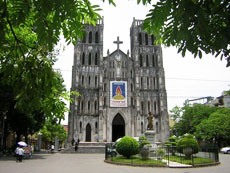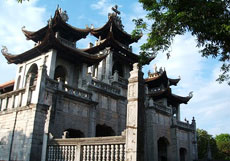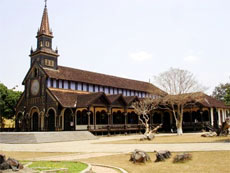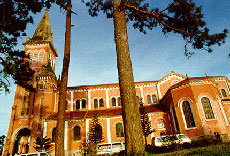In recent years, the Christmas is no longer a festival of the Christians but also of many non-religious Vietnamese people. The peaceful spirit of the Christmas is overwhelming across Vietnam. The churches are being decorated by colourful Santa Clauses, Christmas trees and decorative snow. This is the place where many Christians and non-religious people gather to welcome the Christmas and New Year.
 Hanoi Cathedral
Hanoi Cathedral
Hanoi Cathedral is at 40 Nha Chung Street, Hoan Kiem District, Hanoi. It was built on the site of the former Bao Thien Tower, which was famous in the ancient capital of Thang Long under the Ly Dynasty.
Hanoi Cathedral, also known as Saint Joseph's Cathedral, was inaugurated on Christmas 1886. Its design is based on the Gothic architecture and similar to the architecture of Notre Dame Cathedral in Paris: square towers, an elaborate altar and colourful stained glass windows. Unlike the many churches in the Southern provinces of Vietnam, which are constructed mostly of stone, the Hanoi Cathedral was built of brick made in nearby provinces. The cathedral is 64.5m long, 20.5m wide and 31.5m high with heavy stone pillars in four corners.
The cathedral has one main door and two secondary doors in two bell-towers. All the doors and windows of the cathedral are sharp, typical characteristic of Gothic architecture. The worshipping area decorated with red lacquer trimmed with gold has terra-cotta statue of Saint Joseph with height of over 2m.
The cathedral is usually one of the most crowded areas of the city on any Catholic festival day. On Christmas Eve, hundreds of people gather in the intersection where the cathedral locates in to welcome Christmas.
Basilica of Phu Nhai
Basilica of Phu Nhai is located in Xuan Truong District, Nam Dinh Province with Spain architecture style. Built in 1886, the basilica is 80m long, 27m wide, 30m high. Four bells cast in France with weight of 2,000kg; 1,200kg; 600kg and 100kg are found in two 44m-high bell-towers. The basilica of Phu Nhai always attracts locals and visitors especially in Catholic festival days with many cultural activities.
 Phat Diem Cathedral
Phat Diem Cathedral
Located in Phat Diem Town, Kim Son District, Ninh Binh Province, Phat Diem Cathedral is a harmonious combination between the architecture of Vietnamese pagodas and European churches.
Phat Diem Cathedral built between 1875 and 1899 consists of a network of pond, Phuong Dinh, 1 main church with 4 small churches in its two sides, 1 stone church, artificial mountain and caves.
The Phuong Dinh is a 3-storey stone architecture with height of 25m, length of 24m and width of 17m. The pictures of Jesus Christ and saints are sculptured in the walls of Phuong Dinh. A bell is 1.4m in height, 1.1m in diameter, nearly 2 tons in weight is found in the third storey while a big drum in the second storey.
The main church was built in 1891 with height of 15m, length of 74m and width of 21m. The altar in the main church is made of monolithic stone and sculptured typical flowers of four seasons. In both sides of the church are 4 small churches of different styles. Next to the main church is a stone church with its ground, walls, bars, pillars and tie beams all are made of stone.
In the ground of Phat Diem Cathedral, there are artificial mountain and caves with statue of Jesus Christ.
Phat Diem Cathedral is the center of Catholicism in North Vietnam and also a tourist site attracting a lot of international and domestic visitors.
 Kon Tum Wooden Church
Kon Tum Wooden Church
Built by a French priest named Guise Decrouille in 1913 and finished in 1918, the wooden church is at Kon Tum Town, Kon Tum Province and made of high-quality wood as rosewood and ca chit.
Being combination between Romanesque-blended-with-Gothic architecture and Vietnam's Central Highlands style, the church stands on 1m-high wooden pillars like many communal houses in Central Highlands and includes complex of works: church, lounge, house for displaying handicrafts of ethnic minority groups, communal house, shelter-house for orphaned children and old people, brocade weaving and sewing workshop and carpentry workshop. The church’s pillars and wooden frames are tightly put together. Ceiling is made of rattans, bamboo battens, soil, and straw. The holy area is decorated in the Central Highlands style to make it suitable to the traditional culture of the people in the region.
More than a place of worship for Catholics, the church has been turned into a culture and tourism place in Kon Tum Province.
 Dalat Cathedral
Dalat Cathedral
Located in Tran Phu Street, Dalat City, Lam Dong Province, Dalat Cathedral is one of the most ancient and typical architectures in Dalat.
The cathedral was built between 1931 and 1942 with length of 65m, width of 14m and height of 47m. Therefore the people can see high bell-tower in the distance. The cathedral is also known as Nha Tho Con Ga (Rooster Cathedral) because there is a bronze statue of rooster with length of 0.66m and height of 0.58m on the top of the bell-tower. Based on Gothic architecture, the cathedral’s interior is decorated by 70 French-made stained glass windows. The cathedral is a symbol of Dalat City and attracts many the visitors.
 Saigon Notre Dame Basilica
Saigon Notre Dame Basilica
Located in the heart of the Ho Chi Minh City, the Saigon Notre Dame Basilica attracts not only for its classical beauty of Romanesque-blended-with-Gothic architecture but also original interior and unique rare antiquities
The basilica was built in 1877 and completed in 1880 with length of 93m, width of 35.5m and height of 57m (from the ground to the bell tower). All necessary materials, from cement to steel rods and screws were brought from France. Especially, the tiles to cover the facade which were ordered from Marseille (France), without any mortar coating, always maintain a rosy-red brilliance, with neither dusts nor moss and lichens.
Set of six huge bells in two bell-towers, with a total weight of 28,850 kg, sounding the six musical notes: do, re, mi, sol, la, si, were manufactured in France and carried over to Saigon in 1879.
The giant clock under the vault between the two bell-towers is another rare antiquity. It was made in Switzerland in 1887, weighing more than 1,000 kg.
The basilica’s interior is composed of the central nave and two aisles, with two chapels attached. All its ornaments and decorative patterns are of Romanesque and Gothic arts, elegant yet solemn. Its high altar is made of monolithic marble with the engravings of six angels supporting the canon table, with the pedestal of three compartments, each being a carving describing a religious relic.
The basilica has been not only a place for the Catholic congregation to perform services and celebrate ceremonies but also a favourite destination for Saigonese as well as the visitors.
Thuy Hang